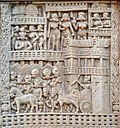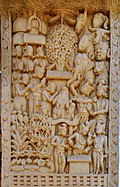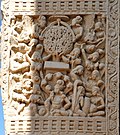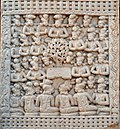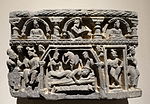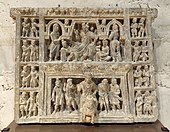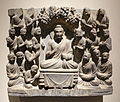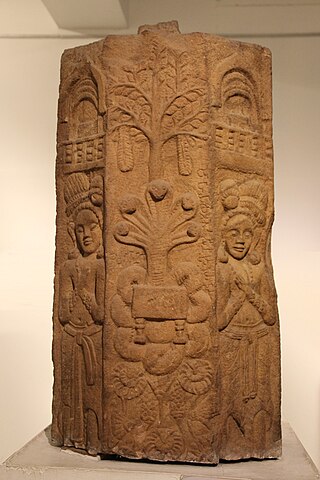
Mucalinda, Muchalinda or Mucilinda is the name of a nāga, a snake-like being, who protected the Gautama Buddha from the elements after his enlightenment.

The Sarvāstivāda was one of the early Buddhist schools established around the reign of Ashoka. It was particularly known as an Abhidharma tradition, with a unique set of seven Abhidharma works.

Buddhist symbolism is the use of symbols to represent certain aspects of the Buddha's Dharma (teaching). Early Buddhist symbols which remain important today include the Dharma wheel, the Indian lotus, the three jewels and the Bodhi tree.

Buddhist texts are religious texts that belong to, or are associated with, Buddhism and its traditions. There is no single textual collection for all of Buddhism. Instead, there are three main Buddhist Canons: the Pāli Canon of the Theravāda tradition, the Chinese Buddhist Canon used in East Asian Buddhist tradition, and the Tibetan Buddhist Canon used in Indo-Tibetan Buddhism.
Buddhist culture is exemplified through Buddhist art, Buddhist architecture, Buddhist music and Buddhist cuisine. As Buddhism expanded from the Indian subcontinent it adopted artistic and cultural elements of host countries in other parts of Asia.

The Greco-Buddhist art or Gandhara art is the artistic manifestation of Greco-Buddhism, a cultural syncretism between Ancient Greek art and Buddhism. It had mainly evolved in the ancient region of Gandhara, located in the northwestern fringe of the Indian subcontinent.

Much Buddhist art uses depictions of the historical Buddha, Gautama Buddha, which are known as Buddharūpa in Sanskrit and Pali. These may be statues or other images such as paintings. The main figure in an image may be someone else who has obtained Buddhahood, or a boddhisattva, especially in the various traditions of Mahayana Buddhism. Other Buddhas and bodhisattvas in art have become increasingly common over the centuries, perhaps now outnumbering images of the historical Buddha.

There are no extant representations of the Buddha represented in artistic form until roughly the 2nd century CE, probably due to the prominence of aniconism in Buddhism in the earliest extant period of Buddhist devotional statuary and bas reliefs. A number of early discourses describe the appearance of the Buddha, and are believed to have served as a model for early depictions. In particular, the "32 signs of a Great Man" are described throughout the Pali Canon, and these are believed to have formed the basis for early representations of the Buddha. These 32 major characteristics are also supplemented by another 80 secondary characteristics (Pali:Anubyanjana).

Buddhist meditation is the practice of meditation in Buddhism. The closest words for meditation in the classical languages of Buddhism are bhāvanā and jhāna/dhyāna.
Aniconism is the absence of artistic representations (icons) of the natural and supernatural worlds, or it is the absence of representations of certain figures in religions. It is a feature of various cultures, particularly of cultures which are based on monotheistic Abrahamic religions. The prohibition of material representations may only extend from God and other supernatural beings to saint-like characters, or it may extend to material representations of all living beings, and material representations of everything that exists. The phenomenon is generally codified by religious traditions and as such, it becomes a taboo. When it is enforced by the physical destruction of images, aniconism becomes iconoclasm.

In Buddhism, an arhat or arahant is one who has gained insight into the true nature of existence and has achieved Nirvana and liberated from the endless cycle of rebirth.

Buddhism has existed in Greece since antiquity. Today, there is a sizable Buddhist community in Greece, comprising immigrants and native Greek converts. Buddhism has influenced Greek literary tradition to some extent, as evident in the works of Nikos Kazantzakis.

The Hetoimasia, Etimasia, prepared throne, Preparation of the Throne, ready throne or Throne of the Second Coming is the Christian version of the symbolic subject of the empty throne found in the art of the ancient world, whose meaning has changed over the centuries. In Ancient Greece it represented Zeus, chief of the gods, and in early Buddhist art it represented the Buddha. In Early Christian art and Early Medieval art it is found in both the East and Western churches, and represents either Christ, or sometimes God the Father as part of the Trinity. In the Middle Byzantine period, from about 1000, it came to represent more specifically the throne prepared for the Second Coming of Christ, a meaning it has retained in Eastern Orthodox art to the present.
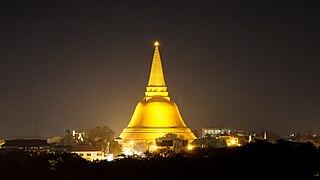
Cetiya, "reminders" or "memorials", are objects and places used by Buddhists to remember Gautama Buddha. According to Damrong Rajanubhab, four kinds are distinguished in the Pāli Canon: "Relic [Dhatu], Memorial [Paribhoga], Teaching [Dhamma], and votive [Udesaka]." Griswold, in contrast, states that three are traditional and the fourth, the Buddha Dhamma, was added later to remind monks that the true memory of Gautama Buddha can be found in his teachings. While these can be broadly called Buddhist symbolism, the emphasis tends to be on a historical connection to the Buddha and not a metaphysical one.

Tipiṭaka or Tripiṭaka, meaning "Triple Basket", is the traditional term for ancient collections of Buddhist sacred scriptures.

The Buddhist traditions have created and maintained a vast body of mythological literature. The central myth of Buddhism is the life of the Buddha. This is told in relatively realistic terms in the earliest texts, and was soon elaborated into a complex literary mythology. The chief motif of this story, and the most distinctive feature of Buddhist myth, is the Buddha's renunciation: leaving his home and family for a spiritual quest. Alongside this central myth, the traditions contain large numbers of smaller stories, which are usually supposed to convey an ethical or Buddhist teaching. These include the popular Jātakas, folk tales or legends believed to be past lives of Gautama Buddha. Since these are regarded as episodes in the life of the Buddha, they are treated here as “myth”, rather than distinguishing between myth, legend, and folk-tale.

Chinese Buddhist sculpture has been produced throughout the history of Buddhism in China. Sculptural pieces include representations of Siddhārtha Gautama, often known as the "Enlightened One" or "Buddha", Bodhisattvas, monks and various deities. China was introduced to the teachings of Buddhism as early as the 2nd century BCE, during China's Han dynasty, becoming more established during the 2nd century CE. The earliest representations did not start as sculptures of the human form, but rather an empty seat, footprint, tree or stupa, an architectural form eventually inspiring the creation of pagodas in China.

The lotus throne, sometimes called lotus platform, is a stylized lotus flower used as the seat or base for a figure in art associated with Indian religions. It is the normal pedestal for divine figures in Buddhist art and Hindu art, and often seen in Jain art. Originating in Indian art, it followed Indian religions to East Asia in particular.

The Kimbell seated Bodhisattva is a statue of a "bodhisattva" from the art of Mathura, now in the Kimbell Art Museum in Fort Worth, Texas. The statue is dated to 131 CE, by an inscription recording its dedication in "Year 4 of the Great King Kanishka", since the date of the beginning of Kanishka's reign is thought to be 127 CE. The Kimbell seated Bodhisattva belongs to the category of the "Seated Buddha triads", which can be seen contemporaneously in the Greco-Buddhist art of Gandhara and in the art of Mathura in the early Kushan period.

Narrative images of episodes from the life of Gautama Buddha in art have been intermittently an important part of Buddhist art, often grouped into cycles, sometimes rather large ones. However, at many times and places, images of the Buddha in art have been very largely single devotional images without narrative content from his life on Earth.





